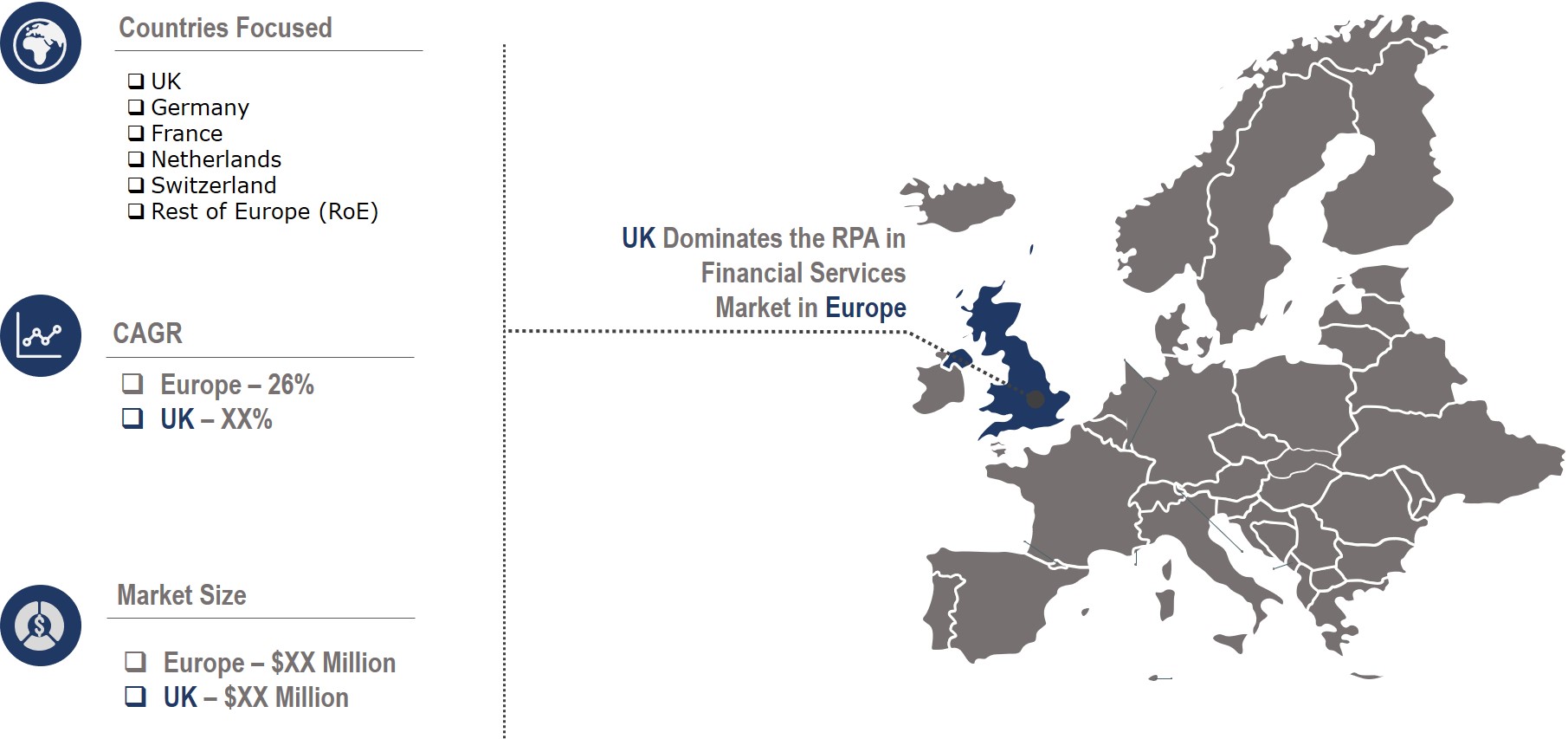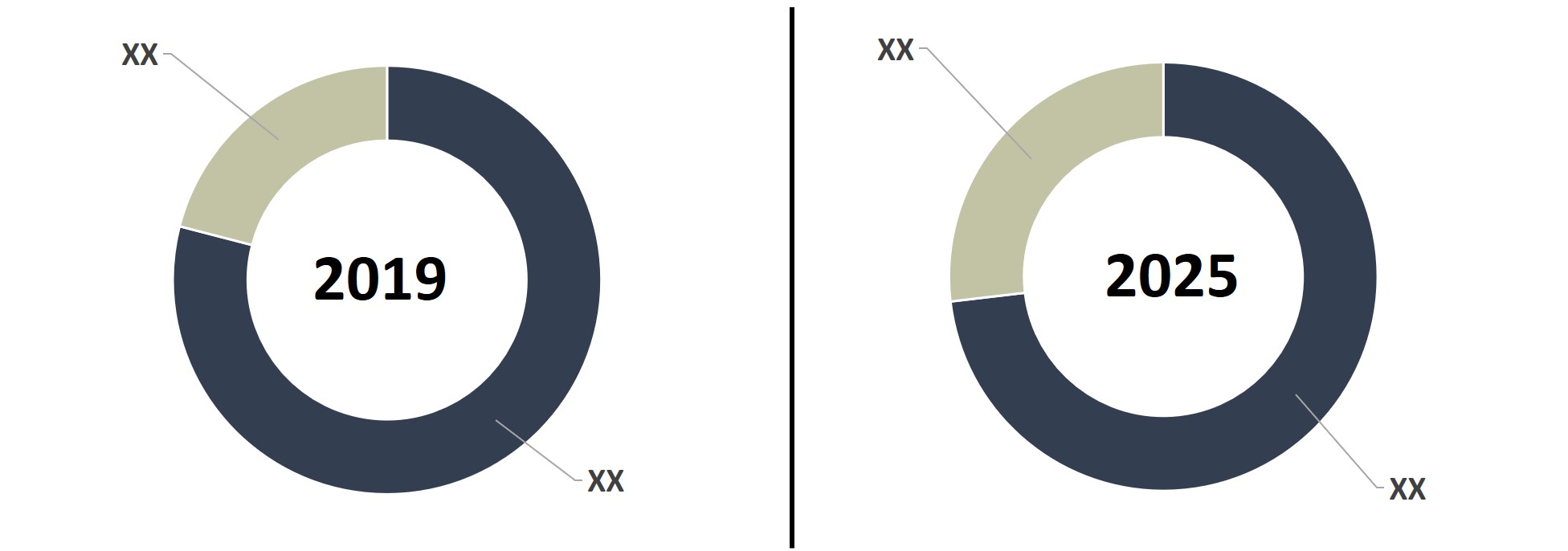
Europe Robotic Process Automation (RPA) in Financial Services Market Forecast 2019–2025
- Domain: ICT - Software & Services
Robotic process automation (RPA) is an application technology that simulates the human workforce interaction with the business systems, which allows staff in an organization to configure the software bots to capture and interpret the existing business applications. RPA in finance applications enables companies to automate the business process and simultaneously assist employees to enhance their accuracy and reliability. Ideally, there are two classes of RPA: routine work automation (rule-based) – data entry, validation, data query with the help of structured data and advanced automation (knowledge-based) – utilizes technologies such as natural language processing and deep learning to automate non-routine tasks, supports decision making with the help of advanced AI functionalities.
Market Dynamics – Europe RPA in Financial Services Market
With the progression from manufacturing, the robotic automation in Europe is now finding space in automating repetitive tasks across various service sectors, including banking, finance and insurance (BFSI). European financial firms are in the strategic transformation stage with the focus on automation to enhance operational efficiency. Increasing focus on automating the accounting & reporting processes along with rising interest in digital solutions to maximize the speed of business is the key factor contributing to the growth of the Europe RPA in financial services market during the forecast period.

Increasing focus on integrating digital robots into the operating environment to automate rule-based tasks in both back-end and front-end processes by entities operating in the financial service industry is driving the growth of the Europe RPA in financial services market. Additionally, financial institutes across various countries in the European region have started strategically allotting budgets to trial advanced technologies such as AI for creating a future operating model that is expected to accelerate the growth of the Europe RPA in financial services market during the forecast period. However, the lack of expertise with financial knowledge along with robotic automation skills is identified as restraint likely to deter the progression of the Europe RPA in financial services market during the forecast period.
Market Segmentation – Europe RPA in Financial Services Market
The Europe RPA in financial services market is segmented based on component, operation, business function, and country. Based on components, the Europe RPA in financial services market is segmented into software and services. The services segment is sub-segmented into implementation, support and maintenance, and training and education. By operation, the Europe RPA in financial services market is segmented into rule-based and knowledge-based. By business function, the Europe RPA in financial services market is segmented into asset management, fund and security services, retail and lending management trading and financial management, and insurance.

Country-level Outlook – Europe RPA in Financial Services Market
In terms of country-wise analysis, the Europe RPA in financial services market is segmented into Germany, UK, France, Netherlands, Switzerland and the Rest of Europe. Among these countries, the UK dominates the Europe RPA in financial services market and is expected to remain dominant throughout the forecast period. This is mainly due to increasing investment in process automation solutions to improve the quality of routine tasks. Moreover, the UK's EU exit is expected to create a significant resource shortage, which in turn is anticipated to increase the demand for RPA in financial services in the UK.
Benefits and Vendors – Europe RPA in Financial Services Market
The study on the Europe RPA in financial services market contains an in-depth analysis of vendors, which includes financial health, business units, key business priorities, SWOT, strategies, and views; and competitive landscape. A few of the key players highlighted in this study include Blue Prism, Redwood Software, Automation Anywhere, Inc., WorkFusion, Inc., Appian, UiPath, SAP, Another Monday, Cortex Ltd., and AntWorks.
The study offers a comprehensive analysis of the “Europe RPA in Financial Services Market”. Bringing out the complete key insights of the industry, the report aims to provide an insight into the latest trends, current market scenario, and technologies related to the market. In addition, it helps the venture capitalists to understand the revenue opportunities across different segments to make better decisions.
- Industry Outlook
- Industry Overview
- Industry Trends
- PEST Analysis
- Report Outline
- Report Scope
- Report Summary
- Research Methodology
- Report Assumptions
- Market Snapshot
- Total Addressable Market
- Segmented Addressable Market
- Related Markets
- Market Outlook
- Overview
- Porter 5 (Five) Forces
- Market Characteristics
- Evolution
- Market Segmentation
- Market Dynamics
- Market Drivers
- Market Restraints
- Market Opportunities
- DRO – Impact Analysis
- Component: Market Size & Analysis
- Overview
- Software
- Services
- Consulting
- Implementation
- Support and Maintenance
- Training and Education
- Operation: Market Size & Analysis
- Overview
- Rule-based
- Knowledge-based
- Business Function: Market Size & Analysis
- Asset Management
- Fund and Security Services
- Retail and Lending Management
- Trading and Financial Management
- Insurance
- Country: Market Size & Analysis
- Overview
- Market Size and Analysis
- Germany
- UK
- France
- Netherlands
- Switzerland
- Rest of Europe (RoE)
- Overview
- Companies to Watch for
- Blue Prism
- Redwood Software
- Automation Anywhere, Inc.
- WorkFusion, Inc.
- UiPath
- Appian
- SAP
- Another Monday
- Cortex Ltd.
- AntWorks
- Competitive Landscape
- Competitive Comparison Analysis
Annexure
Abbreviations
Research Framework
Infoholic Research works on a holistic 360° approach in order to deliver high quality, validated and reliable information in our market reports. The Market estimation and forecasting involves following steps:
- Data Collation (Primary & Secondary)
- In-house Estimation (Based on proprietary data bases and Models)
- Market Triangulation
- Forecasting

Market related information is congregated from both primary and secondary sources.
Primary sources
Involved participants from all global stakeholders such as Solution providers, service providers, Industry associations, thought leaders etc. across levels such as CXOs, VPs and managers. Plus, our in-house industry experts having decades of industry experience contribute their consulting and advisory services.
Secondary sources
Include public sources such as regulatory frameworks, government IT spending, government demographic indicators, industry association statistics, and company publications along with paid sources such as Factiva, OneSource, Bloomberg among others.






